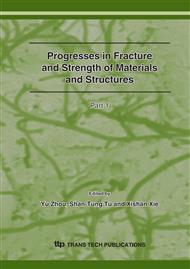p.2353
p.2357
p.2361
p.2366
p.2371
p.2375
p.2379
p.2383
p.2387
A Study of Magnetic Charge per Unit Area of Dipole Model for the NDE
Abstract:
Nondestructive testing using magnetic field is useful for detection of a crack on ferromagnetic material. The magnetic field distribution has to be obtained for quantitative evaluation of crack direction, size, and shape. Also, a crack can be evaluated by using the inverse problem analysis. However, an analysis method using a dipole model can be used to analyze the magnetic field distribution around a crack at a higher speed than the finite element method (FEM). Therefore, a dipole model simulation can provide useful information which can be used for the inverse problem analysis. However, the magnetic charge per unit area, m, and the permeability, μ, has been treated as constants. Therefore, analyzed results have been different from experimental results in most cases. This paper proposes the improved dipole model simulation method, which assumes that the magnetic charges per unit area exist at the section areas, edge lines and summits of a crack. Also, the magnetic charges per unit area were assumed to depend on the square of the crack depth. The improved method is validated by comparing its results with the experiment results obtained with the use of the magnetic camera.
Info:
Periodical:
Pages:
2371-2374
Citation:
Online since:
September 2007
Authors:
Price:
Сopyright:
© 2007 Trans Tech Publications Ltd. All Rights Reserved
Share:
Citation:


